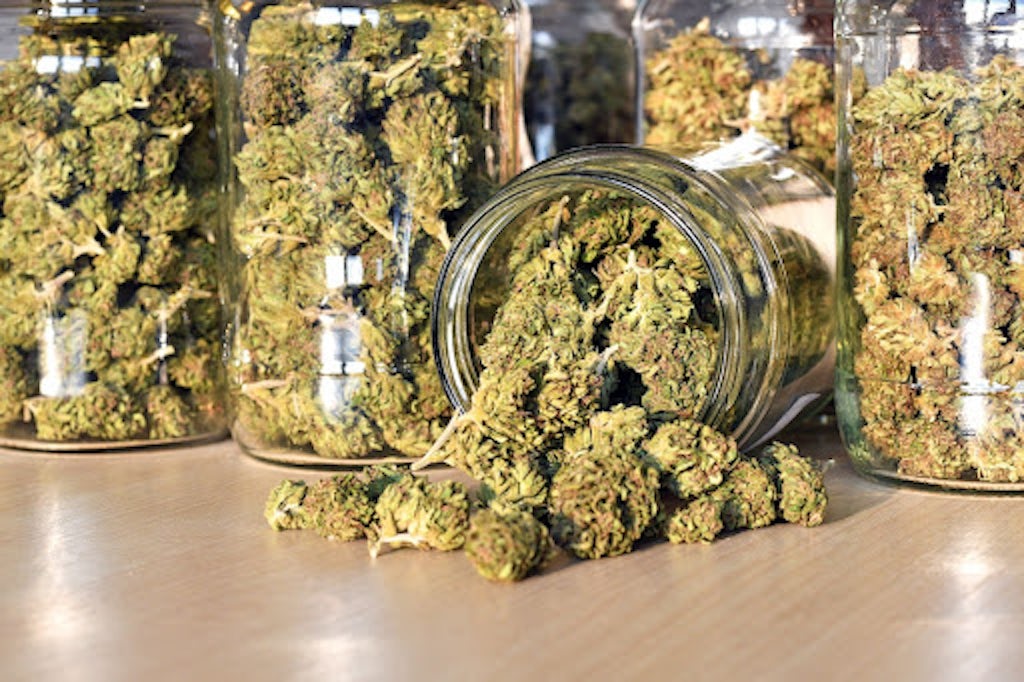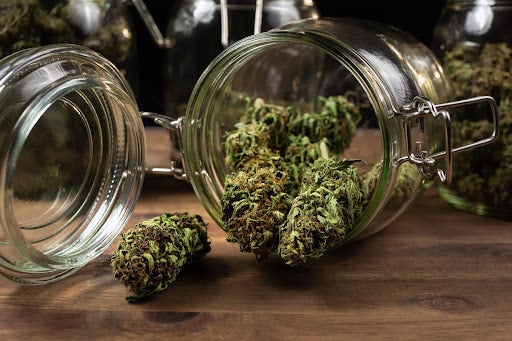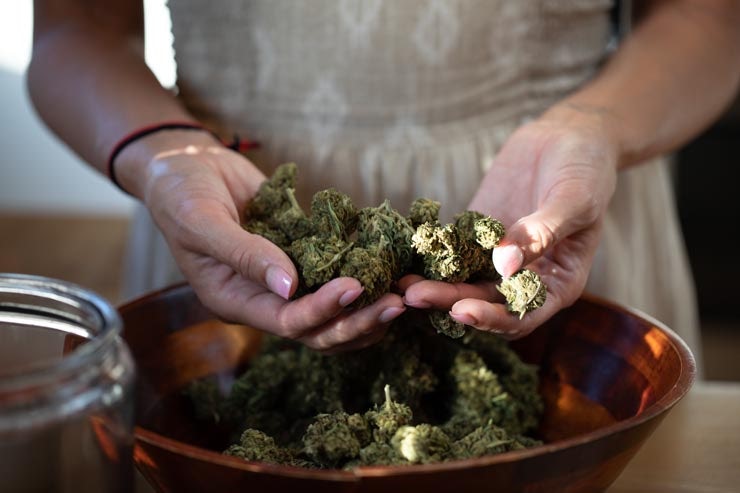If you’ve gotten your cannabis wet, there is a good chance you’re gonna want to throw it out, as wet weed is a prime place for mold to grow. But if you’re desperate or just keen to salvage your herb, don’t despair (yet) – all may not be lost!
You may be able to save your bud, depending on how it got wet. If your cannabis fell into the ocean or a pool loaded with chemicals, it’s time to say goodbye. But if you knocked over the bong or spilled a bit of water on your supply, there may still be hope. THC isn’t water-soluble, so spilled water won’t ruin the cannabinoids and there are steps you can take to potentially rescue your cannabis.
Of course if you spilled a drink like milk, juice, or soda you should reconsider saving your herb, as that could be a recipe for quick mold growth.
Wet weed vs moist buds
Moist buds aren’t the same as wet buds.
Freshly harvested cannabis is moist because it hasn’t yet been dried and cured. These flowers are distinguishable from aged buds by their smell; think raw plant matter versus aged weed. 1 Moist buds will slowly dry in their own time as long as they are properly stored. Wet weed, on the other hand, is saturated with liquid and must be addressed immediately.
Wet weed is also different from sticky weed. Potent flower loaded with trichomes can stick to your fingers and leave a tacky substance, but this isn’t water. The trichomes are home to the cannabinoids and terpenes; the primary compounds that create the effects we know and love. Trichomes on properly dried and cured cannabis are sticky and will hold tight to your fingers, while wet weed will just squish. 2
But if your weed has come into contact with water and is indisputably wet, it’s time to take action.
What happens when weed gets wet?
Wet weed is a major bummer. Not only does getting your weed wet deplete the flavor, aroma, and usability, it can also encourage mold growth.
If your bud is completely soaked through or you don’t know when it got wet, throw it out. It doesn’t take long for mold to start to grow, and consuming moldy cannabis can be dangerous. Even industrially-grown cannabis can suffer from mold growth, which presents an immediate health risk. 3
Mold and fungi flourish in warm, damp conditions but you can usually see it taking hold. Your weed is beyond saving if you notice any of the following: 4
- White, powdery mildew: while this is common on the leaves of the plant, it can also affect the flowers.
- Botrytis (“bud rot” or grey mold): this mold can be grey or brown and occurs in the colas of the cannabis plant. Check your big nugs!
- Web-like fungi: this is a general term for several types of fungi that can be brown, white, or grey. This fungi looks like fuzz or cobwebs.
You may also be able to smell the mold before you can see it. If your cannabis changes from smelling like… well, cannabis to something sweaty or musty, mold is likely present. Your weed doesn’t have to be wet for mold to occur either. While cannabis sold on the legal market must be tested for mold, cannabis sold in the legacy market is not held to the same standard. Always inspect your flowers before consuming them if they don’t have a certificate of analysis (COA).
Moldy weed is not smokable weed. At the least, moldy weed will act as an irritant in your throat and change the flavor. But mold inhalation can be incredibly dangerous for those with a weakened immune system, which can include people taking certain medications. Moldy cannabis has been linked to developing chronic pulmonary diseases, 5 pulmonary infections, and in a few cases, death. 6
And while the repercussions of consuming moldy weed are rarely this serious, it does make you wonder – should you just throw this wet weed out? The choice is ultimately yours – only you know how wet your weed is and how long it’s been wet (and if you don’t know – throw it out.)
Can you smoke wet weed?
So what about salvageable wet weed? The worst part about getting cannabis wet is that you can’t smoke it (at least not well.)
Wet weed doesn’t grind easily and can clog up the teeth of your grinder. It’s also hard to burn – if you can even get it lit. Airflow is restricted in the damp buds so oxygen can’t travel. You’ll need to let your weed dry out completely before attempting to smoke it. And even that isn’t a sure thing.
If you got your weed wet after it was rolled in a blunt or joint wrap, you may still be able to save it, but you likely won’t be able to save the wrap. Remove the cannabis from the paper and consider following one of the drying methods below. If you only got the paper a little wet, then you may be able to dry the joint with the help of the lighter
How to dry wet weed
Before diving into these methods, it’s important to note that salvaging wet weed is not an area with any scientific research, nor will it be any time soon. As such, these methods may or may not work. User discretion and best judgment is advised.
These methods are a combination of common sense, anecdotal evidence, and trial and error–not scientific evidence. But smoking weed that’s gotten wet can come with serious health risks if it’s not properly dried, so proceed at your own risk, and when in doubt, throw it out.
There is no concrete answer for how long it will take to dry your weed; it can take under an hour or up to three days. You should only try these methods if your weed has just gotten wet. Do not try to salvage any weed that has been wet for an undetermined amount of time.
Additionally, the time that it takes for your weed to dry out using one of these methods is enough for mold to grow. Always keep a close eye on your weed while it’s drying and when in doubt (about mold growth) throw it out. It’s not worth risking your health to salvage some potentially smokable weed.
1. Paper towels
Drying your weed in paper towels is simple. In addition, you’ll also need a fan or a dehumidifier.
- Wrap the flower in paper towels and move into a dark dry location.
- Set the fan or dehumidifier up nearby to move the air or remove the moisture, respectively.
- Change the paper out and rotate the bud every few hours to prevent mold growth, as mold loves humidity. Continue to do this until the cannabis feels dry and firm to the touch, usually for at least 24 – 48 hours.
2. Paper bag
Similar to the paper towel method, paper bags adopt the wait and draw-out method of moisture removal.
- Place your weed in a paper bag with a paper towel at the bottom.
- Put the bag in a dark dry room with airflow (you can use a fan) and replace the paper towel every few hours.
- Turn your weed to each time you change the towel to prevent mold growth and allow it to sit like this for at least 24- 48 hours, or until dry.
3. Rice
From smartphones to cannabis, there’s not much that rice can’t dry.
- Fill a mason jar halfway with rice and put the cannabis in.
- Cover the cannabis with rice and allow the jar to sit in a dark dry space uncovered for at least 24- 48 hours.
- You can also point a fan or dehumidifier at the jar to circulate the air.
- If your weed is dry when you remove it, you’re good to go. But if there’s still a little moisture in the buds, break them up with your fingers and move on to the paper towel technique.
4. Oven
If you’re not willing to wait 24 hours or more for your weed to dry, you can always pop it in the oven. It’s important to note that putting it in the oven will decarboxylate the cannabis, making it better suited to use in edibles and tinctures, rather than smoking. Additionally heating it in the oven will release some terpenes and you can expect your kitchen or house to have a weed-like odor.
- Crush the weed with your fingers as best you can and lay it out on a tray.
- Bake in the oven at 245 F for 30 – 40 minutes before removing and letting it cool.
- Store it in a cool, dark place to come to room temp.
5. Humidity pack
If your weed is just a little damp and not full-on soggy, you can add a humidity pack to your storage container to help draw out the moisture.
- Allow the jar to sit for up to 3 days after the pack is placed to draw out the moisture.
- The pack will store the moisture so it doesn’t degrade the buds, but it can also add moisture back to your weed if it gets too dry in storage.
How not to dry wet weed
Panic can set in when you realize your weed has gotten wet, but don’t make a bad situation worse and damage your weed beyond usability. When in doubt, use common sense and throw out your wet weed.
The internet is rife with “creative” ways to dry your weed that do more harm than good. Don’t try to dry your wet weed with:
- A microwave. Blasting your weed with electromagnetic radiation is a surefire way to ruin a smooth hit and potentially destroy the cannabinoids. It also creates a strong and unpleasant odor.
- A hair blow-dryer. A blow dryer on low may work for smaller, whole cannabis buds, but it won’t get the job done for big buds or ground weed. The hot air won’t be able to penetrate the density of the big buds, drying it unevenly, and it will simply blow away ground cannabis.
- Lay it out in the sun. Sunlight is not reliable enough to dry out your cannabis effectively – it can even begin to degrade the cannabinoids and the terpenes, converting THC into CBN, and changing the potency of your herb.
Store your cannabis properly

How could you have avoided wet weed in the first place? Keeping your cannabis stored properly reduces the chances of moisture or mold growth and can extend the shelf life up to one year, and even then there will be some slight degradation. To store your weed for maximum shelf life:
- Use an airtight container, preferably glass
- Store it in a dark dry place that stays under 70F
- Use a humidity pack to control the moisture
Never store your weed in plastic bags, in the fridge, or in the freezer.
Getting your weed wet can be a frustrating experience, and the desire to save it can be very strong. But wet cannabis quickly turns to moldy cannabis and the best choice is almost always to toss it out. If you save your herb, recognize you’re assuming the risk of mold growth. If you do save your ganja and want to dry it, you can try the steps above and proceed with caution.
Sources
- AL Ubeed HMS, Wills RBH, Chandrapala J. Post-Harvest Operations to Generate High-Quality Medicinal Cannabis Products: A Systemic Review. Molecules. 2022; 27(5):1719. https://doi.org/10.3390/molecules27051719
- Thompson GR 3rd, Tuscano JM, Dennis M, et al. A microbiome assessment of medical marijuana. Clin Microbiol Infect. 2017;23(4):269-270. doi:10.1016/j.cmi.2016.12.001
- Tanney CAS, Backer R, Geitmann A, Smith DL. Cannabis Glandular Trichomes: A Cellular Metabolite Factory. Front Plant Sci. 2021;12:721986. Published 2021 Sep 20. doi:10.3389/fpls.2021.721986
- Punja, Z. K., Collyer, D., Scott, C., Lung, S., Holmes, J., & Sutton, D. (2019). Pathogens and Molds Affecting Production and Quality of Cannabis sativa L. Frontiers in plant science, 10, 1120. https://doi.org/10.3389/fpls.2019.01120
- Gargani Y, Bishop P, Denning DW. Too many mouldy joints – marijuana and chronic pulmonary aspergillosis. Mediterr J Hematol Infect Dis. 2011;3(1):e2011005. doi:10.4084/MJHID.2011.005
- Ruchlemer R, Amit-Kohn M, Raveh D, Hanuš L. Inhaled medicinal cannabis and the immunocompromised patient. Support Care Cancer. 2015;23(3):819-822. doi:10.1007/s00520-014-2429-3
Sign up for bi-weekly updates, packed full of cannabis education, recipes, and tips. Your inbox will love it.

 Shop
Shop Support
Support



















